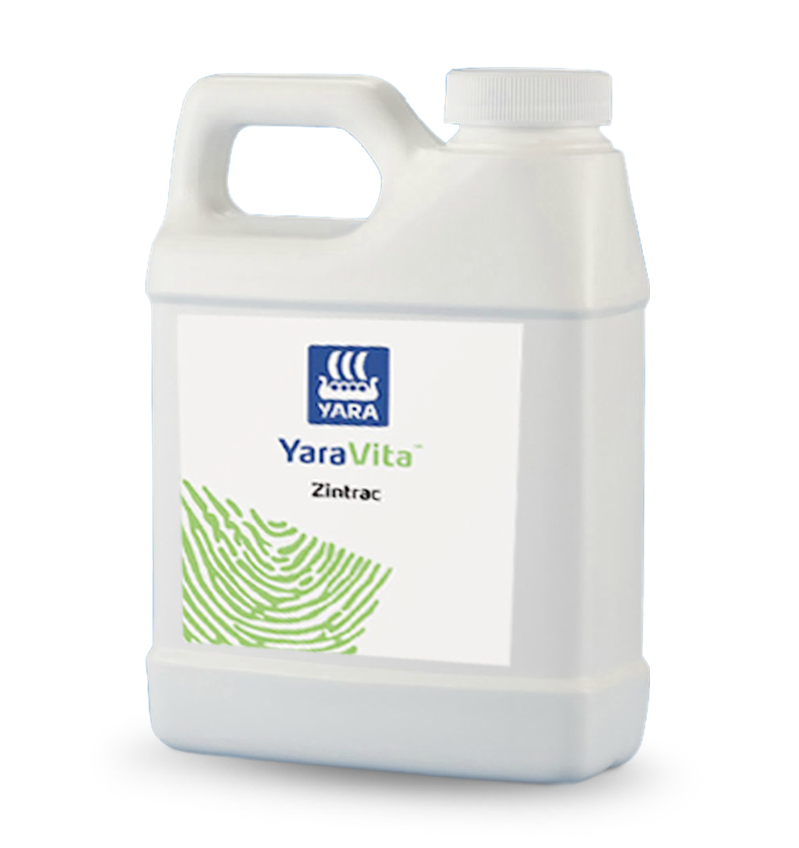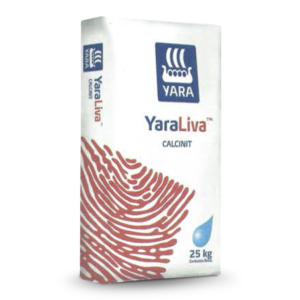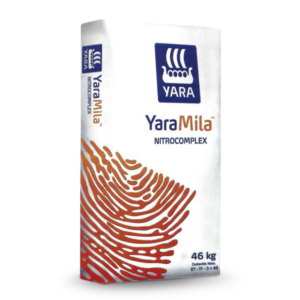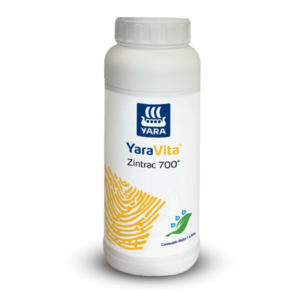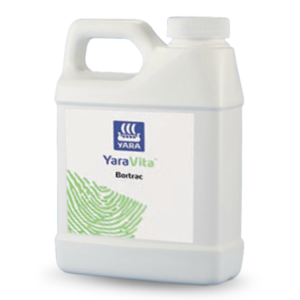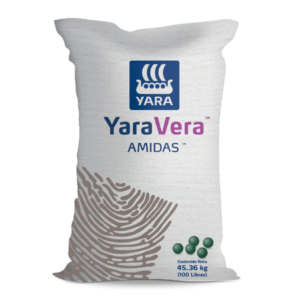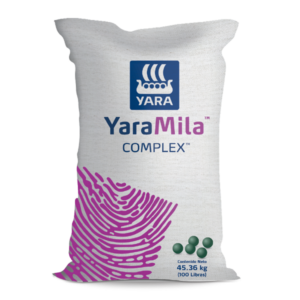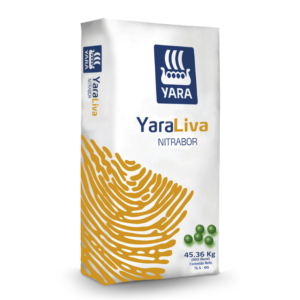Yara Vita Zintrac

A formulated product for the treatment of boron deficiency by foliar application.
- Formulated for safe application at critical growth stages to satisfy crop requirements.
- Widely tank mixable with other crop sprays.
- Proven, reliable performance. Trialled and tested on a wide range of crops around the world.
- High quality, consistent product. Manufactured to ISO 9001 quality assurance standards.
- Easy to use liquid formulation. Pours and disperses easily and quickly into the spray tank.
- High nutrient content means lower application rates reducing handling time and waste packaging.
Download Spec Sheet
Guaranteed AnalysisRecommendations
YaraVita Zintrac™ GUARANTEED ANALYSIS
| Total Nitrogen(N) | 4.0% |
| Other water-soluble Nitrogen | 4.0% |
| Boron (B) | 10.9% |
| Derived from: Boric Acid, Ethanolamine | |
Typical Crop Recommendations*
| Crop | Recommendations |
| Alfalfa: | 1 pint/acre every cut. Water rate: 5 to 20 gallons/acre. |
| Apples: | 1 pint/acre at pink bud, start of flowering and again at petal fall. Also, 1 quart/acre after harvest but before leaf senescence. Water rate: 50 to 100 gallons/acre. |
| Asparagus: | 1 to 2 quarts/acre applied to ferns prior to senescence. Water rate: 5 to 20 gallons/acre. |
| Aubergine/Eggplant (Field Grown): | 1 quart/acre applied from the 4 to 6 leaf stage onwards. Repeat applications may be necessary. Water rate: 50 gallons/acre. |
| Beans, Peas: | 1 quart/acre at 4 to 6 inches tall stage. For moderate to severe deficiency, a repeat application may be necessary 10 to 14 days later. Water rate: 20 gallons/acre. |
| Blueberries: | Two applications of 1 pint/acre applied at flower bud stage and repeated 10 to 14 days later (start of flowering). Also, apply 1 quart/acre post-harvest, pre-leaf senescence. Water rate: 20 to 50 gallons/acre. |
| Canola: | For a single application, 1½ quarts/acre at onset of stem extension. For moderate deficiency, 1½ quarts/acre at 4 to 6 leaf stage and again at onset of stem extension. An extra application can be made 10 to 14 days later for a severe deficiency. Avoid flowering. Water rate: 5 to 20 gallons/acre. |
| Cole Crops (Broccoli, Brussel Sprouts, Cabbage, Calabrese, Cauliflower, Chinese Cabbage, Collards: | 1½ quarts/acre at 4 to 6 leaf stage with repeat applications at the above rate at 10 to 14 day intervals for moderate to severe deficiency. Water rate: 5 to 20 gallons/acre. |
| Carrots: | 1½ quarts/acre when the crop is 6 inches tall. For moderate to severe deficiency repeat applications at 10 to 14 day intervals. Water rate: 5 to 20 gallons/acre. |
| Celery: | 1½ quarts/acre at the 4 to 6 leaf stage. Repeat 10 to 14 days later if necessary. Water rate: 20 gallons/acre. |
| Citrus: | 2 to 3 pints/acre at white buds or when white buds are separated. Water rate: 50 to 100 gallons/acre. |
| Conifers: | 2 applications of 1½ quarts/acre at the start of new season leaf production, and again in early autumn. Water rate: 50 to 100 gallons/acre. |
| Corn: | 1½ quarts/acre at 4 to 8 leaf stage. For moderate to severe deficiency, a repeat application may be necessary 10 to 14 days later. Water rate: 5 to 20 gallons/acre. |
| Cotton: | 1 quart/acre at 4 to 6 leaf stage, at appearance of first flower bud squares and again at open flowers stage. Water rate: 5 to 15 gallons/acre. |
| Cucurbits, Melons, Squash, Zucchini (Field Grown): | 1 quart/acre from the 4 leaf stage. Repeat at 10 to 14 day intervals if necessary. Water rate: 5 to 20 gallons/acre |
| Groundnuts: | 1 to 2 pints/acre at the 4 to 6 leaf stage. Water rate: 5 to 30 gallons/acre |
| Lettuce (Field Grown): | 1 quart/acre 10 to 14 days after transplanting or emergence. Water rate: 50 gallons/acre. |
| Nuts (Deciduous): | 1 pint/acre at bud break and 1 quart/acre after harvest before senescence. Water rate: 50 to 100 gallons/acre. |
| Onions: | 1 to 2 pints/acre as soon as there is sufficient foliage to intercept spray. A second application may be made at the same rate 10 to 14 days later. Water rate: 5 to 20 gallons/acre |
| Pears: | Three applications of 1 to 2 pints/acre at white bud, start of flowering and again at petal fall. Also, 2 to 3 pints/acre after harvest but before leaf senescence. Water rate: 15 gallons/acre. |
| Peppers (Field Grown): | 1 quart/acre applied at early flowering to fruiting, with two repeat applications at 10 to 14 day intervals if necessary. Water rate: 200 l/ha. |
| Soybeans: | 1 quart/acre when crop is 2 to 6 inches tall, repeated at 10 to 14 day intervals if necessary. Water rate: 5 to 20 gallons/acre. |
| Stone Fruits (Apricots, Cherry, Nectarines, Peach, Plum): | 1 pint/acre at winter bud and again at pink bud. Also, 1 quart/acre after harvest but before leaf fall. Water rate: 50 to 100 gallons /acre. |
| Strawberries (Field Grown): | Two applications of 1 to 1½ pints/acre commencing at green/white bud stage and repeated 10 to 14 days later. 1 quart/acre applied at regrowth (after harvest). Water rate: 20 to 50 gallons/acre. |
| Sugar Beet: | 1½ quarts/acre at 4 to 6 leaf stage. For moderate to severe deficiency, repeat applications should be made at the above rate at 10 to 14 day intervals. Water rate: 5 to 20 gallons/acre. Soil Applied at 2 quarts/acre. |
| Sunflower: | 1 to 1½ quarts/acre from 2 pairs of leaves up to flower bud stage. Repeat if necessary at 10 to 14 day intervals within this period. Water rate: 3 to 20 gallons/acre. |
| Sweet Potatoes: | 1 pint/acre one week after 100% emergence or transplanting. Also, apply at the same rate following recommendation from analysis. Water rate: 20 gallons/acre. |
| Tobacco: | Two applications of 1 quart/acre two to three weeks after transplanting (3 to 4 leaf stage) with 10 days between applications. Water rate: 3 to 50 gallons/acre. |
| Tomatoes (Field Grown): | 1 quart/acre when plants are at 4 to 6 leaf stage. Repeat if necessary at 10 days intervals. Water rate: 5 to 50 gallons/acre. |
| Water Melons (Field Grown): | 0.5 pints/acre. Three applications at 15, 30 and 45 days after germination. Water rate: 40 gallons/acre . |
| Vines: | 1 pint/acre at flower truss visible, at flower buds separated and at fruit set. Also, 1 quart/acre after harvest before leaf senescence. Water rate: 50 to 100 gallons /acre. |
| *The information provided is accurate to the best of Yara’s knowledge and belief. Any recommendations are meant as a guide and must be adapted to suit local conditions. Always read the label before use. | |
CONTACT US
For more information on this product, contact Circle R Products Agro Division.

